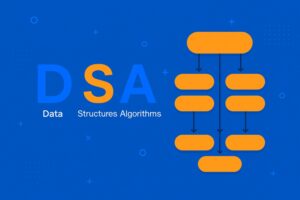What is DSA Tutorial? The Introduction to a Skill that Would Change Your Life
If you’ve ever thought about how fast these apps run and how certain websites know what you need even before you do, then that’s all DSA. And this DSA Tutorial is a formal, informative beginner’s guide to the world of Data Structures and Algorithms. DSA is your secret weapon, best for students who are starting up or for working professionals eyeing better roles.
Getting to know DSA wouldn’t only be for coding interviews. It means developing a way of thinking, being confident, and preparing oneself for complex problem-solving situations at work. We want to skip the jargon and just teach you in a very relatable, practical way in this DSA Tutorial. So, let us jump right into DSA.
Why This DSA Tutorial Is Sufficient to Kickstart Your Journey
What makes it different from the endless DSA tutorials available? This is not just another tutorial for data structures and algorithms, heavy on coding. The focus is now on you, the learner who is juggling assignments, work deadlines, or personal goals. We have devised this tutorial with real-world applications, visual thinking, and simplified concepts.
This DSA Tutorial does not toss you into recursion or linked lists on the first day. Rather, it builds your base slowly. Whether you are stuck at “what even is a stack?” or just want to see patterns in the different types of sorting algorithms, you are covered.
DSA Tutorial Basics: What It Mean by Data Structures and Algorithms?
Cutting it in simple terms, the Data Structures are the methods through which we store and manipulate data. You could think of them as kitchen containers; every one of them serves a certain purpose in life. Arrays, Linked Lists, Stacks, Queues, Trees, and Graphs are your basic kitchen containers.
On the other hand, the word algorithms refers to step-by-step instructions for problem-solving. Algorithms are what work behind the scenes, whether it is sorting your Spotify playlists or searching for that one pesky file in your laptop.
DSA Tutorial: How to Learn DSA Step by Step
So, how to learn DSA without freaking out? Simple: follow the path that we have laid out in the DSA Tutorial.

- Start with Arrays and Strings – The easiest and very relatable
- Move to Stacks and Queues – Grasp memory and order concepts
- Get into Linked Lists – A wee bit tricky but useful in real life
- Master Trees and Graphs – Especially if you’re preparing for product-based companies
- Move into Sorting and Searching Algorithms – Classics like Merge Sort, Quick Sort, and Binary Search
- Work on Time and Space Complexity – With Big O notation, write efficient code
- Problem Solving – Use LeetCode and CodeChef for practice.
This DSA Tutorial teaches you to cultivate a habit of thinking as opposed to mere memorization.
DSA Tutorial for Students: Build Your Foundation Now
If you happen to be a student, this DSA Tutorial is your ticket to internships, placements, and maybe even some competitive exam entries. In many colleges, practical learning is only offered in theory; thus, this guide fills that gap.
Use this DSA Tutorial to:
- Understand the basic programming concepts
- Create projects for your resume
- Prepare for campus placements
Dedicate your weekends to revising a topic and solving anywhere from 5 to 10 problems. The focus should be on how to learn DSA in chunks, and not on cramming the night before. Just trust the process – you’re working out your brain like it’s a gym session.
DSA Tutorial for Working Professionals: Crack Tech Interviews with Confidence
So, you’re already working but want to switch to a better company or role? This DSA tutorial will help you brush up on your logic and coding interview preparation. Most tech interviews start with a DSA round, and failing to perform in it could cause one to lose out on their dream job.
If you are a QA, product analyst, or non-tech background professional aiming for a developer or SDE role, this DSA Tutorial will walk you through the basics again. You will just need 30-45 minutes per day to brush up on concepts and consistently solve 2-3 problems.
The key to learning DSA while working is consistency over intensity.
Let’s accept it – DSA can be monotonous or quite hard at times. But this DSA Tutorial has a few tricks up its sleeves:
- Use pen and paper to dry-run your code.
- Visual Trees and Graphs as maps and family trees.
- Use YouTube for explainer videos; stick to one channel only.
- Keep a study buddy group or join Discord for accountability.
- Don’t jump on the hard questions – get good at the easy ones first.
Because believe me: Every coder has had some moments of crazy confusion due to recursion. This DSA Tutorial encourages you to sustain the fire of curiosity and patient acceptance.
DSA Tutorial Final Notes: What You’ll Achieve
By following this DSA Tutorial, you’ll learn not only how to solve problems but also how to think like a developer. By now, you have been armed to:
- Confidently smash coding rounds
- Build logic-oriented projects
- Speak algorithm language in interviews
- Save valuable time in development work
And really, you’ll stop fearing technical interviews. It doesn’t matter whether you’re 18 or 38; this DSA tutorial is your step towards a sharper brain and smarter coding.

Also Read:
- Docker Tutorial: How to Use Docker, Docker Client & Docker Compose (2025 Insights)
- Maven Tutorial 2025: Everything Beginners Must Know
- The Ultimate Data Analytics Tutorial: For Beginners & Professionals
- Python Variable Tutorial: Scope, Declaration, and Clean Coding Rules (2025 Insights)
Learn DSA with PW Skills – Real Results, Real Mentors
PW Skills offers practical and beginner-friendly courses to master DSA and other courses, delivered by industry experts. From visual tutorials to live doubt-solving sessions, we make DSA easy, interactive, and career-ready. Join the thousands of learners who have transformed their tech careers through us; build confidence, convert that into a job, and solve real-world coding challenges – all at one place.
On an average, a solid grasp of DSA concepts will take 3-4 months with practice for about 1 hour each day. Pick the language that you are most comfortable with. Logic is what matters most. Yes! A lot of successful coders and developers are self-taught. DSA is all about practice and logic. The ability to solve problems faster, recognize patterns in questions, and seek fewer hints – all show growth.DSA Tutorial FAQs
How much time will it take to complete a DSA Tutorial from scratch?
Is it okay to learn DSA in Python or JavaScript instead of C++ or Java?
Can I learn DSA without a computer science degree?
What are some signs I’m improving while learning from a DSA Tutorial?

